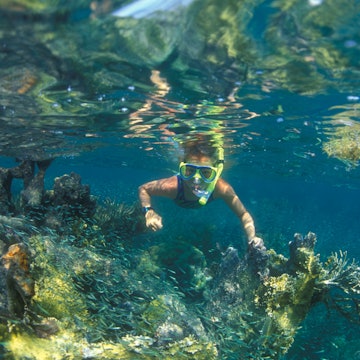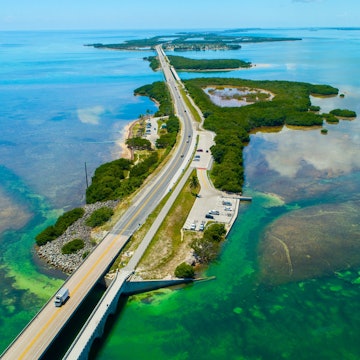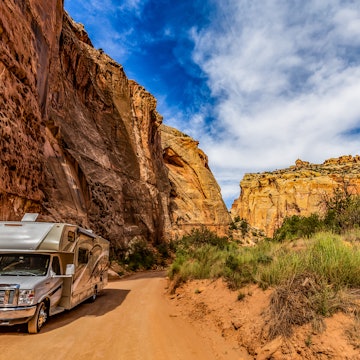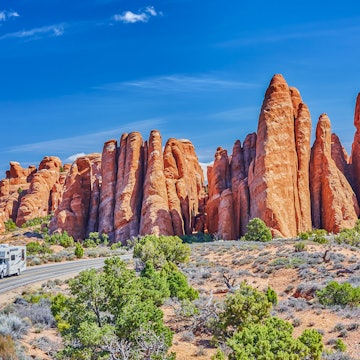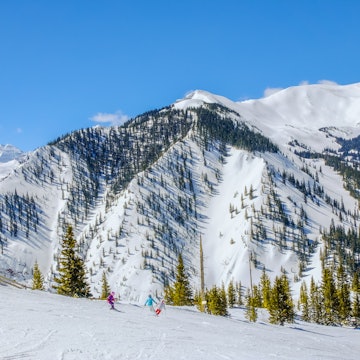
A guide to Florida’s Biscayne National Park



Biscayne Bay off Black Point. Francisco Blanco/Shutterstock
Just south of Miami’s sprawl lies a true natural treasure: Biscayne National Park, 95% of which is made up of the waters of Biscayne Bay and the Atlantic Ocean.
A portion of the world’s third-largest reef sits just off the coast here, along with mangrove forests and the northernmost Florida Keys. Under the surface of the salty water, you can look forward to some of the best reef viewing and snorkeling in all of the USA.
Within the park’s water-surrounded borders lie four distinct ecosystems, each with distinct characteristics. Biscayne Bay, a shallow estuary where fresh and saltwater mix, provides a seagrass-covered sanctuary to marine life like manatees, crustaceans and mollusks. The mainland shores house mazes of mangrove forests, their saltwater-loving tree species acting as natural filters and protection for wildlife. The coral-limestone keys, full of salt-tolerant plants and tropical trees, are home to terrestrial wildlife such as lizards, raccoons and marsh rabbits. And the most colorful ecosystem is the northernmost portion of Florida’s Coral Reef: bright marine life and coral are a feast for the eyes here.
The human presence in the park spans more than 10,000 years, from nomadic prehistoric tribes to folly-fueled developers in the 20th century. Mingling with the reefs on the seabed are dozens of shipwrecks, some dating back to the 18th century. In the 19th and early 20th centuries, homesteaders and Gatsby-esque industrialists once dreamed of developing the area. Today, however, the islands that are part of the national park are gloriously uninhabited, and admiring the wonders of nature is all humans can – and should – do within the park.
Read on for all you need to know before you set out to explore Biscayne National Park.

When should I go to Biscayne National Park?
South Florida is famously warm and humid all year long – but most so in the summer. And while some from cold-weather climes may enjoy the high temperatures of the warmest months, few enjoy the thunderstorms and mosquitos. Which is why the dry season, from November to April, is the best time to visit Biscayne National Park.
In the winter months, Biscayne’s waters are the clearest – but they’re also the coolest, averaging 72°F/22°C in February. (August, by contrast, sees averages of 87°C/30.5°C.) To get the most out of aquatic adventures during these months, consider visiting with a 3mm wetsuit.
The downside of those pleasant temperatures and water clarity? The park can get awfully busy on weekends and holidays, especially with motorboats (and their wakes) on day jaunts from Miami. These peak visitorship days are not ideal for setting out on the water in kayaks, canoes or paddleboards.
In South Florida, thunderstorms can always roll in, especially in summer. Always check the forecast before you set out on the water, and be prepared to return to land when the clouds form, which tends to happen in the afternoon.
The park’s least-visited month is September. If you’re keen to camp out for a night or two and can brave the bugs and mugginess, you may have the park practically to yourself.
How much time should I spend in Biscayne National Park?
Given Biscayne’s close proximity to Miami, many visit the park for the day, or even a half-day. Most start their visit at Dante Fascell Visitor Center, which has exhibitions on ecology, marine life and surrounding human settlement. A brief film gives an overview of Biscayne’s four ecosystems, while the gallery features nature- and wildlife-themed pieces by artists working in a variety of media.
Biscayne National Park Institute offers multiple paid guided water tours, giving visitors a chance to explore via sailboat or kayak or go underwater with scuba or snorkeling gear. These excursions, almost all of which depart from the visitor center, range from 90-minute group kayak tours to full-day scuba adventures for experienced divers. Reserving ahead is recommended.
The park’s two campsites – on Elliott Key and Boca Chita Key, both accessible only by boat – open up the possibility of 2- or 3-day trips to Biscayne National Park, and the chance to explore more of its ecosystems. Since these two keys lie 9 miles across the bay from the boat launch at the visitor center, only experienced kayakers should set out on their own.

Is it easy to get in and around Biscayne National Park?
Biscayne National Park is just a 40-mile drive from downtown Miami, or a 9-mile drive from the center of Homestead (also a gateway to the 1.5 million acres of Everglades National Park). Those arriving by car can park for free at the Dante Fascell Visitor Center. The town of Homestead runs a free bus service to and from the visitor center on weekends between January and early April.
Since most of Biscayne National Park’s 173,000 acres is ocean, you should count on getting in a boat to take in the reserve’s scope. Book a tour with Biscayne National Park Institute (most excursions depart from the visitor center) to set sail on a guided cruise, paddle yourself in a kayak, skim the surface by snorkeling or go deep on a scuba dive.
Experienced paddlers who bring their own craft can kayak the 9 miles from the visitor center to Elliott or Boca Chita Keys, where they can explore the islands and pitch their tents. (All equipment – even fresh water – must be brought in.) The 65-ft-high Boca Chita Lighthouse offers great views of Miami and the surrounding landscape. (Note that it’s currently under construction, enclosed in scaffolding and closed to visitors.)

Top things to do in Biscayne National Park
Most travelers come for a day’s adventure in the national park, which could entail kayaking, snorkeling or island exploring. Wherever you visit in Biscayne, you’re likely to see plenty of seabirds, from cormorants perched on mooring posts and flocks of brown pelicans flying in formation to steely-eyed osprey gliding just above the water. Pods of bottlenose dolphins zip across the horizon, while crabs and lizards scuttle amid the roots of red mangroves along the water’s edge. Under the water, endangered sea turtles and other wondrous creatures live along the world’s third-longest coral-reef tract, and dart among the remnants of six shipwrecked boats strewn across the ocean floor.
Set out for a paddle…
For a closer look at the park’s natural beauty, sign up for a paddling tour, either private or with a larger group. Hidden between Totten Key and Old Rhodes Key, Jones Lagoon has calm, clear waters fringed by mangrove trees. After a 30-minute motorboat ride from the mainland, you’ll hop onto a stand-up paddleboard (which allows better perspectives for viewing marine life than a kayak) and look for great blue herons, great egrets and roseate spoonbills as you glide silently along. In the clear marine waters below, you might spy sea turtles, baby sharks, rays, upside-down jellyfish or sea stars.
…or peek below the surface with a snorkeling or scuba session
Snorkeling trips offer you immersion in Biscayne’s most biologically diverse ecosystem. On a half-day trip, you’ll visit two different sites, exploring coral reefs, a shipwreck, or a bayside setting amid the mangroves, where you can see soft coral and sea sponges. Scuba-certified divers can sign on for a 6-hour trip (two dives). There’s also the option to explore half a dozen sunken ships contained within the park on an excursion to the Maritime Heritage Trail. Three of the vessels are suited for scuba divers, but the others – particularly the Mandalay, a lovely, two-masted schooner that sank in 1966 – can be accessed by snorkelers. Underwater plaques at each shipwreck site tell the full story of each ship and the fate of its passengers and cargo.

Learn about the park’s fascinating human history
The Heritage of Biscayne cruise takes you out across the bay and past Adams, Elliott and Boca Chita Keys. During this 3.5-hour tour, guides bring the islands’ past to life by relating the stories of those who’ve lived here over the years. There was Israel Jones, an African American man who settled on Porgy Key in the 1850s and transformed it into one of South Florida’s most prosperous key lime and pineapple farms. His descendants were instrumental in helping to preserve the islands for future generations (instead of taking a hefty payout from developers).
The industrialist Mark Honeywell left a different mark on Boca Chita Key. After founding his eponymous thermostat and home-heating company, he bought Boca Chita as a holiday retreat, building an ornamental lighthouse and chapel, and polishing up some old Spanish cannons that would be fired to welcome guests to the lavish parties he loved to host. The cruise typically stops at Boca Chita, where you can admire that lighthouse, walk a short nature trail amid the mangroves and enjoy some downtime on the island’s tiny beach.
If you’re aboard your own boat, consider a jaunt past the site known as Stiltsville. Hovering above Biscayne Bay, this collection of wooden structures on stilts dates to the first shack’s construction in the 1930s. In its heyday it was home to as many as 27 buildings, some social clubs or fisheries, others weekend getaways; today, only a handful remain due to the exposed location and havoc-wreaking storms. In 1985, the area became a part of Biscayne National Park, and the structures have been preserved to highlight the park’s marine resources and remain a reminder of the area’s history.

Take a hike on the Spite Highway
On Elliott Key (only accessible by boat), you can hike the longest trail in the national park, a wooded stretch known as the Spite Highway. In the 1960s, developers had grand designs on this coastline, envisioning hotels, roads and even a small airport that would be part of the new city of “Islandia.” Conservationists, however, managed to convince the public that this region was worth preserving. Having lost the public-relations battle, developers brought bulldozers to Elliott Key and blazed a six-lane, 7-mile-long swath down the middle of the island in hopes of spoiling the area’s preservation. Fortunately, their wanton destruction didn’t succeed, and President Lyndon B Johnson signed the bill creating Biscayne National Monument in 1968.
Today, the trail is smooth, flat and generally canopied. Particularly during the spring and summer months, make sure to pack mosquito repellent and long clothing as the swarming can be intense. There are no water vistas on the hike – for those, hit the Elliott Key Loop trail that follows the perimeter of the island.
How much money do I need for Biscayne National Park?
Entry to Biscayne National Park: free
Docking fee at Boca Chita and Elliott Keys: $25 per day (Friday–Monday and federal holidays)
Camping fee at campgrounds on Boca Chita Key and Elliott Key: $35 per night (in addition to any docking fees; available first come, first serve and payable via app)
Ticket for 3.5-hour Heritage of Biscayne boat tour: $83 per adult ($49 per child)
1.5-hour kayak tour through mangroves: $39 per person
Private full-day scuba excursion (two dives) for up to 16: $2,880
This article was adapted from Lonely Planet’s Miami & the Keys guide, published in August 2025.










